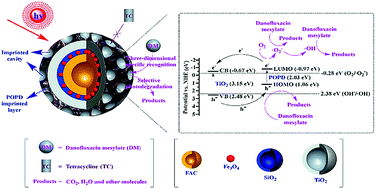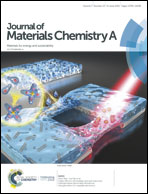Magnetic functional heterojunction reactors with 3D specific recognition for selective photocatalysis and synergistic photodegradation in binary antibiotic solutions†
Abstract
We report on the development of the emerging magnetic functional heterojunction reactors with three-dimensional (3D) specific recognition. Upon synthesis via surface imprinting and visible light-induced polymerization, the developed magnetic functional heterojunction reactors not only possess the emblematic conductive polymer POPD, but they are also equipped with the imprinted cavities in the corresponding 3D specific recognition outer layer. Our experimental data show that POPD forms a heterojunction with TiO2 and remarkably enhances the photocatalytic activity. Owing to the presence of imprinted cavities, the magnetic functional heterojunction reactors exhibit excellent 3D specific recognition and selective degradation of danofloxacin mesylate in a binary antibiotic solution. Importantly, through in-depth understanding of the mechanism and systematic experiments, the electron transfer mode, 3D specific recognition mode, selective photodegradation mode and photodegradation pathways are methodically discussed and thoroughly illustrated. The present study demonstrates that the 3D specific recognition can be utilized to selectively degrade a specific organic pollutant in a variety of practical environmental protection applications.

- This article is part of the themed collection: 2019 Journal of Materials Chemistry A Most Popular Articles


 Please wait while we load your content...
Please wait while we load your content...